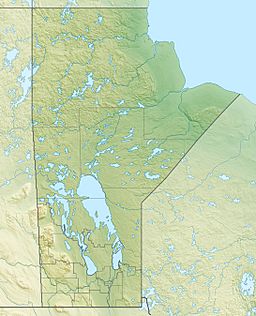Kipahigan Lake facts for kids
Quick facts for kids Kipahigan Lake |
|
|---|---|

The small lake is located north of Flin Flon (marked red) on the border
|
|
| Location | Division No. 21, Manitoba / Division No. 18, Saskatchewan |
| Coordinates | 55°21′N 101°58′W / 55.350°N 101.967°W |
| Basin countries | Canada |
Kipahigan Lake is a fascinating lake in Canada. It's special because it sits right on the border between two provinces: Manitoba and Saskatchewan. This small lake is about 50 kilometers (31 miles) north of a town called Flin Flon.
Contents
Where is Kipahigan Lake?
Kipahigan Lake is found in the central part of Canada. It's located in a northern area where forests and many other lakes are common. The lake's unique position means it's part of both Manitoba and Saskatchewan. This makes it a cool example of how natural features can cross political lines.
A Border Lake
Imagine a lake split in half! That's kind of like Kipahigan Lake. One side is in Manitoba, and the other is in Saskatchewan. This border isn't just on land; it goes right through the water. It's a great example of how geography shapes our world.
Nearby Towns and Nature
The closest town is Flin Flon, which is known for its mining history. The area around Kipahigan Lake is mostly wilderness. This means it's a place with lots of trees, wildlife, and natural beauty. It's a quiet spot, far from big cities.
What Makes Lakes Important?
Lakes like Kipahigan are very important for many reasons. They provide homes for different plants and animals. They also play a big role in the local environment.
Home for Wildlife
Many types of fish live in lakes. Birds often visit lakes to find food or to rest during their long journeys. Mammals, like moose or bears, might come to the lake to drink water. Lakes are busy places for nature!
Part of the Water Cycle
Lakes are a key part of Earth's water cycle. Water flows into them from rivers or rain. Water also evaporates from the lake surface, forming clouds. This cycle helps keep our planet's water moving.
Exploring Canadian Lakes
Canada is famous for having many lakes. In fact, it has more lakes than almost any other country! These lakes come in all shapes and sizes.
Glacial Lakes
Many Canadian lakes, including those in Manitoba and Saskatchewan, were formed by glaciers. Thousands of years ago, huge sheets of ice moved across the land. As they melted, they left behind depressions that filled with water. This created the beautiful lakes we see today.
Outdoor Activities
Lakes in Canada are popular for outdoor fun. People enjoy fishing, boating, and canoeing. In winter, some lakes freeze over, allowing for ice skating or ice fishing. These activities help people connect with nature.
Kipahigan Lake, though small, is a great example of Canada's natural beauty. Its location on a provincial border makes it a unique spot. It reminds us of the amazing geography of our world.


